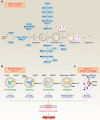Ferroptosis: molecular mechanisms and health implications
- PMID: 33268902
- PMCID: PMC8026611
- DOI: 10.1038/s41422-020-00441-1
Ferroptosis: molecular mechanisms and health implications
Abstract
Cell death can be executed through different subroutines. Since the description of ferroptosis as an iron-dependent form of non-apoptotic cell death in 2012, there has been mounting interest in the process and function of ferroptosis. Ferroptosis can occur through two major pathways, the extrinsic or transporter-dependent pathway and the intrinsic or enzyme-regulated pathway. Ferroptosis is caused by a redox imbalance between the production of oxidants and antioxidants, which is driven by the abnormal expression and activity of multiple redox-active enzymes that produce or detoxify free radicals and lipid oxidation products. Accordingly, ferroptosis is precisely regulated at multiple levels, including epigenetic, transcriptional, posttranscriptional and posttranslational layers. The transcription factor NFE2L2 plays a central role in upregulating anti-ferroptotic defense, whereas selective autophagy may promote ferroptotic death. Here, we review current knowledge on the integrated molecular machinery of ferroptosis and describe how dysregulated ferroptosis is involved in cancer, neurodegeneration, tissue injury, inflammation, and infection.
Conflict of interest statement
The authors declare no competing interests.
Figures







References
-
- Bieri JG. An effect of selenium and cystine on lipide peroxidation in tissues deficient in vitamin E. Nature. 1959;184:1148–1149. - PubMed
-
- Moore B, Hawkes JL. An investigation of the toxic actions of dilute solutions of the salts of certain heavy metals (viz.: copper, iron, nickel, cobalt, manganese, zinc, silver, and lead) upon the Bacillus Typhosus, with a view to practical application in the purification of shell-fish. Biochem. J. 1908;3:313–345. - PMC - PubMed
Publication types
MeSH terms
Substances
Grants and funding
LinkOut - more resources
Full Text Sources
Other Literature Sources
Medical

